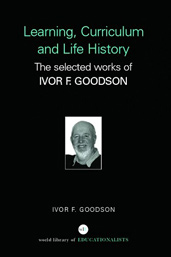Learning, Curriculum and Life Politics: the selected works of Ivor F. Goodson
Representing Teachers
The argument for listening to teachers is, therefore, a substantial and long overdue one. Narratives, stories, journals, action research and phenomenology have all contributed to a growing movement to provide opportunities for teacher representations. In the case of stories and narratives, Kathy Carter has provided a valuable summary of this growing movement in the early years of its educational incarnation:
With increasing frequency over the past several years we, as members of a community of investigator–practitioners, have been telling stories about teaching and teacher education rather than simply reporting correlation coefficients or generating lists of findings. This trend has been upsetting to some who mourn the loss of quantitative precision and, they would argue, scientific rigour. For many of us, however, these stories capture, more than scores or mathematical formulae ever can, the richness and indeterminacy of our experiences as teachers and the complexity of our understandings of what teaching is and how others can be prepared to engage in this profession.
It is not altogether surprising, then, that this attraction to stories has evolved into an explicit attempt to use the literatures on ‘story’ or ‘narrative’ to define both the method and the object of inquiry in teaching and teacher education. Story has become, in other words, more than simply a rhetorical device for expressing sentiments about teachers or candidates for the teaching profession. It is now, rather, a central focus for conducting research in the field (Carter 1993, p. 5).
Story and History
The emphasis upon teachers’ stories and narratives encouragingly signifies a new turn in presenting teachers. It is a turn that deserves to be taken very seriously, for we have to be sure that we are turning in the right direction. Like all new genres, stories and narratives are Janus-faced; they may move us forward into new insights or backwards into constrained consciousness – and sometimes simultaneously.
This uncertainty is well stated in Carter’s summary of ‘The place of story in the study of teaching and teacher education’:
Anyone with even a passing familiarity with the literatures on story soon realizes, however, that these are quite turbulent intellectual waters and quickly abandons the expectation of safe passage toward the resolution, once and for all, of the many puzzles and dilemmas we face in advancing our knowledge of teaching. Much needs to be learned about the nature of story and its value to our common enterprise, and about the wide range of purposes, approaches, and claims made by those who have adopted story as a central analytical framework. What does story capture and what does it leave out? How does this notion fit within the emerging sense of the nature of teaching and what it means to educate teachers? These and many other critical questions need to be faced if story is to become more than a loose metaphor for everything from a paradigm or world view to a technique for bringing home a point in a lecture on a Thursday afternoon (Carter 1993, p. 5).
